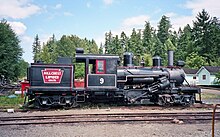Geared locomotive

Geared locomotives were steam locomotives in which the power was transmitted from the steam engine to the drive wheel set with a gear transmission.
history
Field and forest railways often ran on routes with tight curves and steep inclines, with often only provisional and poorly laid tracks . In order to cope with these conditions, locomotives were required that were powered on all axles and also had to be as small and manoeuvrable as possible.
These requirements resulted in geared locomotives in which all axles are driven by gear drives. They were mainly used in logging, where wooden planks - rails were initially used. The shape of the wheels was similar to the rims of motor vehicles. Later normal tracks in normal and narrow gauge were used. Of the four American types Shay, Climax, Heisler and Baldwin, around 4,000 copies were built between 1880 and 1945 and thus documented both the great need for such locomotives and their operational suitability despite the complex overall structure. These very successful machines stimulated the construction of comparable types in countries with similar operating conditions; New Zealand is a particularly striking example . The Davidson, Johnston and Price designs were created here.
Types
Shay type
The Shay locomotive was the most popular geared locomotive. Its inventor was Ephraim Shay , who ran a small sawmill in Michigan in the USA and was looking for a suitable machine for his forest railways with their uneven tracks. In the winter of 1873/74 he realized his idea and over the next few years he improved it again and again until it met the requirements. When a neighbor also wanted such a locomotive, Shay referred him to Lima Machine Works, which also accepted the order and delivered the first copy in 1880. It resembled a four-axle flat car with a vertical boiler , on the right-hand side of which the vertical steam engine was mounted, which drove the axles via cardan shafts and bevel gears located outside the bogies . This made the entire propulsion system easily accessible.
In 1881 Shay gave all rights to the Lima Machine Works ; this should create one of the most important locomotive factories in the USA. Lima soon developed designs with a horizontal boiler that was shifted to the left to achieve an even weight distribution. In 1884 a Shay locomotive received a third motor bogie for the first time. This was followed by types with three-cylinder steam engines that ran quieter and more evenly. Around 1900, with the 150 t design, a locomotive with four powered bogies appeared for the first time, two of which carried the tender. They were used as push-pull locomotives on the Chesapeake & Ohio and Western Maryland Railway .
In 1945 Lima manufactured the last Shay locomotive with the B'B'B 'wheel arrangement for the Western Maryland Railway; Weighing 147 t and almost 20 m long, she worked on a connecting railway to a coal mine.
Shay locomotives are still in service on some museum railways today.
Climax type
Charles D. Scott was the inventor of another type of geared locomotive. In 1888 he turned to Climax Manufacturing Comp. in Corry , Pennsylvania , which took over the production of the Climax locomotives, where George Gibert issued the first patent for the design. Here, too, there was initially a vertical boiler on a flat car, the steam engine was in front of the boiler in the middle of the car, the axles were driven via cardan shafts and bevel gears. The next step was to use horizontal kettles, and from 1891 onwards the cylinders, which were mostly sloping upwards, were on the sides of the frame. The drive shaft strand remained in the middle of the locomotive.
The scale of the Climax locomotives built with their two bogies ranged from ten-tonne to powerful 100-tonne machines. The first Climax with three motor bogies left the factory in 1897. From 1923 on, improved designs also had superheaters, cast steel bogies and compressed air brakes. The last such locomotive was built in 1928, locomotives built between 1030 and 1060 speak for the reliability of this design as well.
Heisler type

Charles Heisler developed the geared locomotive design named after him. The cylinders were in a V-shape in front of the fire box , the drive was via cardan shafts on the outer bogie axles, and coupling rods made the connection to the inner ones. The boiler could also remain in the middle of the vehicle, the main gear on the crankshaft required for the Climax was omitted.
The first Heisler locomotive was built in 1891, and machines with three motor bogies appeared from 1900. Heisler locomotives had a good reputation thanks to their robust and simple design. A total of around 850 pieces were built, the last one left the Heisler Locomotive Works in 1945 .
literature
- Raimar Lehmann: Steam locomotive special designs . 2nd unchanged edition. VEB Verlag Technik, Berlin 1987, ISBN 3-341-00336-3 .
Web links
Individual evidence
- ↑ Patent US421894 : Tramway Locomotive. Published February 25, 1890 , inventor: Rush S.Battles.
- ^ Ed Vasser: Climax Shop Numbers Class C. (No longer available online.) In: Climax Locomotives. Archived from the original on October 23, 2013 ; accessed on March 18, 2018 (English). Info: The archive link was inserted automatically and has not yet been checked. Please check the original and archive link according to the instructions and then remove this notice.
- ^ Ed Vasser: History Of The Climax Locomotive. Climax Production. In: Climax Locomotives. Accessed March 10, 2018 .



